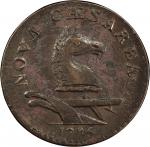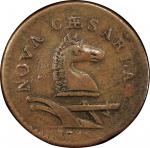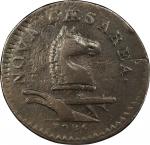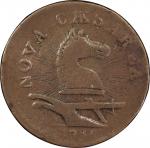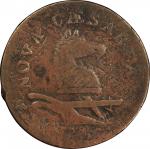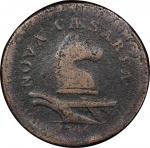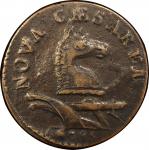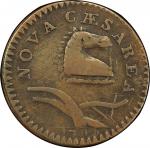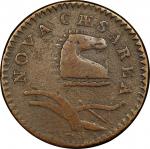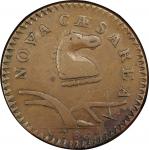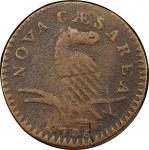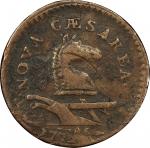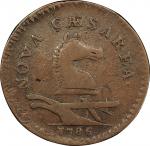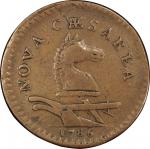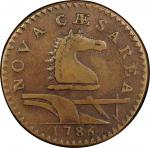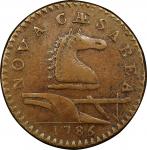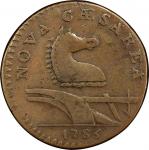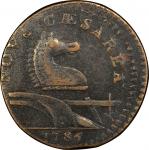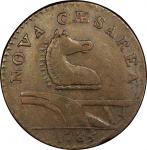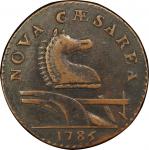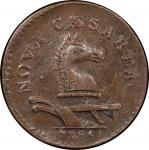1786 New Jersey copper. Maris 17-b. Rarity-3. Large planchet. PLUKIBUS. Overstruck on a 1788 Connecticut copper, M. 10-C. AU-53 (PCGS).136.0 grains. A memorably high grade example of this variety, ranked as fourth finest known in the SHI Census and boasting a fine, old provenance. Fresh, frosty golden brown surfaces retain strong luster and hints of mint color among some obverse design elements. The strike is strong, with full shield details and a well defined eye. The centering is close to ideal, perhaps aligned just trivially to the right on the obverse. The undertype is clear enough for identification, with the distinctive form of the laurel held by the Connecticut’s seated figure still visible between the horse’s ear and C of CAESAREA. The hair tie of the Connecticut’s obverse portrait may be seen, flattened but well defined, at the central peak of the shield. The reverse shows some laminations, the longest of which runs through R of PLURIBUS and the letters of UNUM, and a pretty substantial lamination is present at the lower right of the shield. No major post-striking flaws are present, just an old scratch between UR of PLURIBUS and a few trivial vertical pinscratches that are hard to find behind the horse’s head. The die state is still early enough that the R of PLURIBUS is intact, Die State 1.<p>This piece is listed as fourth finest known in the SHI Census, trailing the Ellsworth-Garrett coin in the Anton Collection, the primary Boyd-Ford coin (a Small Planchet specimen), and the boldly overstruck Maris-Garrett coin. This variety has two major subvarieties: large planchet coins, which almost always show visible undertypes, and the small planchet coins, which were struck on short, thick virgin planchets of similar weight but smaller diameter. A small number of contemporarily made cast counterfeits are also known, molded from a small planchet coin and placed into circulation.<p>In the 1991 description for this coin, written just months after PCGS began grading colonial issues, the cataloger mused “In the case of the presently offered specimen, for example, the presence of mint color, some luster, and highly glossy surfaces suggests a choice AU grade, if not a strict MS-60, as Ryder suggested with his adjectival grade. The present writer prefers to err on the conservative side when grading New Jersey coppers struck over host coins, since they were clearly intended for circulation use. One wonders how PCGS would grade such an overstrike, particularly in those cases where the parasite’s types are very indistinct and sharpness cannot be used as a guide.” Nearly three decades later, we have our answer: cautious conservatism, with a lower grade than the AU-55 to AU-58 assigned in Frontenac or Ryder’s “Uncirculated, defects in metal.”<p>Technically, Ryder was probably right. By the way modern collectors view colonial coppers, PCGS is probably right too.From the E Pluribus Unum Collection of New Jersey Coppers. Earlier, from William Hesslein’s sale of the Edward Miller Collection, April 1916, lot 667; Hillyer Ryder Collection; Hillyer Ryder Estate (1928) to Wayte Raymond, 1944; F.C.C. Boyd Collection; F.C.C. Boyd Estate to John J. Ford, Jr.; Bowers and Merena’s Frontenac sale, November 1991, lot 132.

